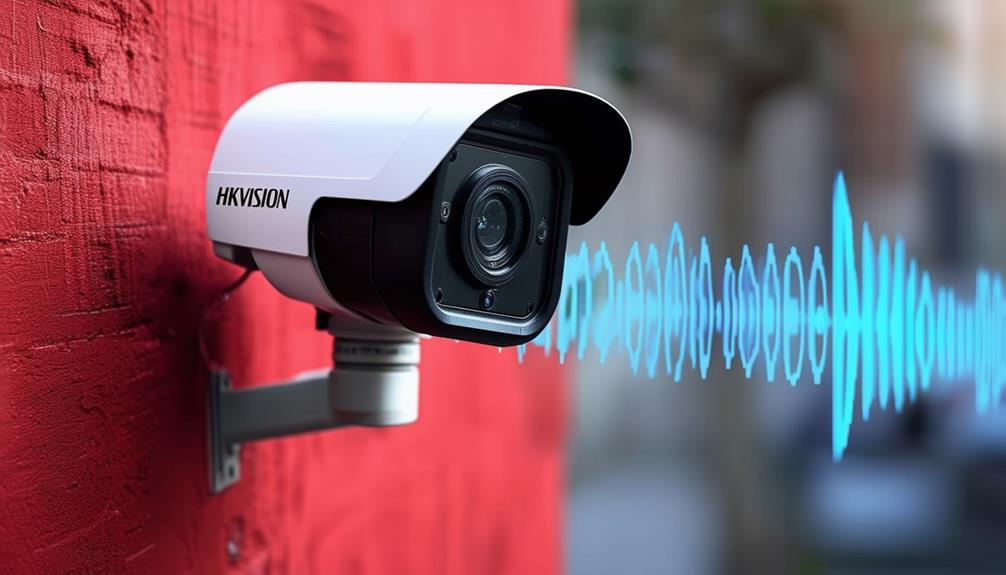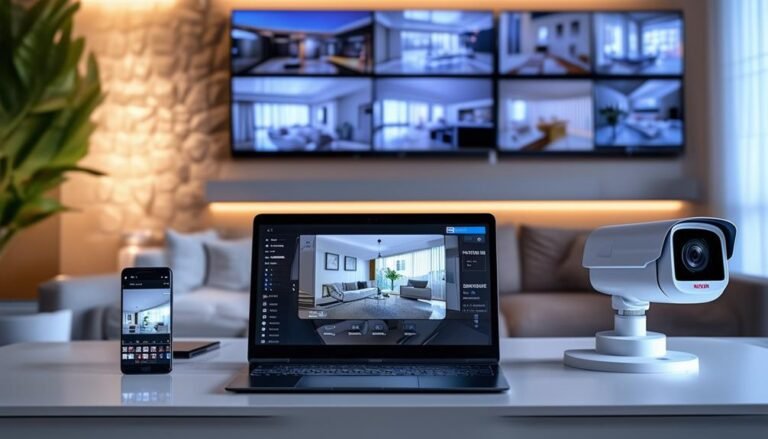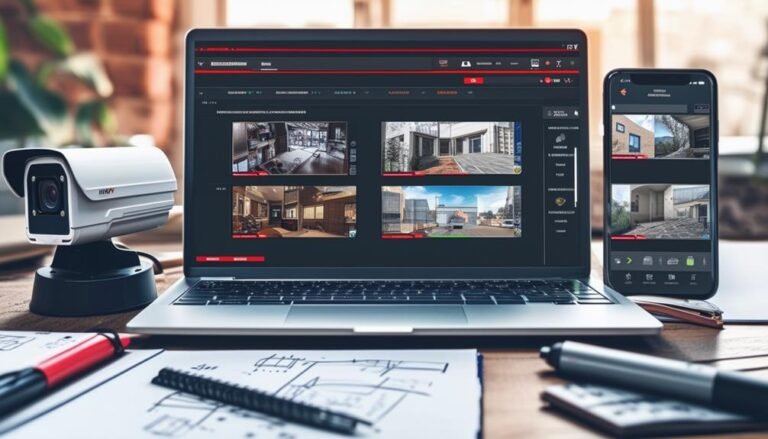Yes, Hikvision does record audio, allowing you to capture sound along with video for enhanced surveillance. Many Hikvision camera models come with built-in microphones, while others support external microphones for even better audio quality. These features enable two-way communication and help you gain critical insights during incidents. It's essential to recognize, though, that using audio recording must comply with local laws regarding consent and privacy. Setting up audio recording is straightforward, ensuring you get the most out of your surveillance system. There's plenty more to discover about how to maximize your Hikvision setup.
Hikvision Audio Recording Capabilities
Hikvision cameras offer various audio recording capabilities that can enhance your surveillance system. Whether you're monitoring your home, business, or outdoor spaces, having audio can add an extra layer of security. You can capture not just the visuals but also the sounds that accompany them, giving you a fuller picture of what's happening in real-time.
Many Hikvision models come equipped with built-in microphones, so you don't have to worry about additional equipment. These cameras can record audio alongside video, allowing you to hear conversations and other sounds that might be essential during an incident. This feature can be particularly useful if you're looking to guarantee that your environment remains peaceful and secure.
For those who want more flexibility, Hikvision also offers models that support external microphones. This means you can position the microphone exactly where you need it, capturing sounds from a specific area or increasing the overall audio quality. Plus, some cameras allow for two-way audio communication, enabling you to speak directly through the camera. This can be a game-changer for remote monitoring, letting you interact with visitors or warn off intruders.
Ultimately, incorporating audio recording into your surveillance setup can empower you by providing critical information and enhancing your awareness. With Hikvision's robust audio capabilities, you can take control of your security and guarantee that you're always in the know.
Types of Hikvision Cameras
When it comes to surveillance, choosing the right type of camera is essential for effective monitoring. Hikvision offers a range of cameras designed to fit various needs, ensuring you can find the perfect match for your security requirements.
One popular option is the bullet camera. These are sleek, cylindrical in shape, and can be mounted on walls or ceilings. Bullet cameras are great for long-distance viewing, making them ideal for outdoor applications where you want to monitor wide areas like parking lots or entryways.
Then, there are dome cameras. These are more discreet and less obtrusive, perfect for indoor settings. Their design makes it harder for intruders to tell which direction the camera is facing, which can be a significant advantage in deterring unwanted behavior.
If you need coverage over large areas, consider Hikvision's PTZ (Pan-Tilt-Zoom) cameras. These versatile units allow you to control the camera's movement remotely, zoom in on specific details, and pan across a wide field of view. PTZ cameras are particularly useful for monitoring events or locations that require active surveillance.
For those looking for a more integrated solution, Hikvision also offers models with advanced features, such as built-in analytics and night vision capabilities. No matter your needs, Hikvision provides a variety of camera types to enhance your security setup, allowing you to feel empowered and in control of your surveillance choices.
Microphone Options for Recording
When it comes to recording audio with Hikvision cameras, you've got some choices. You can use built-in microphones, which offer convenience, or opt for external ones for enhanced sound quality. Understanding these options will help you decide what best suits your recording needs.
Built-in Microphone Features
Integrating built-in microphone features into surveillance systems enhances audio capture capabilities greatly. These microphones can considerably improve your monitoring experience. You'll find they provide a seamless way to gather audio alongside video, ensuring you don't miss critical sounds during events.
Here's a quick overview of the built-in microphone features you might find:
| Feature | Description | Benefits |
|---|---|---|
| Noise Reduction | Filters out background noise | Clearer audio capture |
| Directionality | Focuses on specific sound sources | Enhances relevant audio |
| High Sensitivity | Captures soft sounds | Better detection of activity |
| Adjustable Gain | Allows you to control audio levels | Customizable to your needs |
| Integration with Video | Syncs audio with video footage | Thorough monitoring |
These features empower you to monitor your environment more effectively, giving you the freedom to respond to incidents as they happen. With built-in microphones, you won't just see what's going on; you'll hear it too, making your surveillance system all the more robust and reliable.
External Microphone Compatibility
While built-in microphones offer valuable audio capabilities, many users seek even more flexibility with external microphone options. Hikvision cameras are designed to be compatible with a variety of external microphones, giving you the freedom to choose the best solution for your recording needs. You can connect external microphones through the audio input ports available on many Hikvision models, allowing for enhanced audio capture in diverse environments.
When selecting an external microphone, consider your specific requirements. For example, shotgun mics are great for focused audio in noisy settings, while lavalier mics are perfect for interviews, providing hands-free convenience. You'll find that some external options even support advanced features like noise cancellation, guaranteeing crisp, clear sound.
Connecting an external mic can greatly elevate your audio quality, making it ideal for security applications, video production, or even live streaming. It's crucial to check the compatibility of your chosen microphone with your Hikvision device, as this guarantees seamless integration and peak performance. With the right external microphone, you'll gain the flexibility you need to record professional-quality audio, enhancing your overall recording experience.
Audio Formats Supported
When it comes to audio formats, you'll want to know what codecs Hikvision supports for recording. Different codecs can affect the quality of your recordings, so it's crucial to evaluate your options. Let's look at the various audio codecs available and the recording quality you can expect.
Supported Audio Codecs
In recent years, Hikvision has made significant advancements in the audio capabilities of its surveillance systems, supporting a variety of audio codecs. This flexibility allows you to choose the format that best suits your needs, ensuring your audio recordings are as effective as possible.
Among the supported audio codecs, you'll find G.711, G.726, and AAC, each offering unique benefits. G.711 is a standard codec widely used for its simplicity and compatibility, making it a reliable choice for many users. G.726, on the other hand, provides better compression, allowing for efficient use of bandwidth without sacrificing much regarding audio quality. If you're looking for a more modern solution, AAC is a great option, delivering superior sound quality, particularly for more complex audio.
Recording Quality Options
Hikvision offers various recording quality options to cater to different surveillance needs, guaranteeing you can capture audio clearly and effectively. When you're setting up your system, you'll find that the brand supports multiple audio formats like PCM, G.711, and G.726, giving you flexibility based on your specific requirements.
If you're concerned about storage, you can choose a compressed format like G.726, which provides decent quality while saving space. For situations where clarity is essential, opting for PCM can deliver high-fidelity sound, though it may require more storage.
You'll also appreciate the ability to adjust the bitrate, allowing you to balance between audio quality and file size. A higher bitrate results in clearer audio, but don't forget it'll consume more storage. It's all about finding that sweet spot that meets your needs while giving you the freedom to manage your resources effectively.
With these options, you can tailor your Hikvision system to guarantee that your audio recordings are as effective as possible, empowering you to maintain the security and peace of mind you deserve.
Use Cases for Audio Recording
Audio recording enhances surveillance systems by providing a detailed understanding of events as they unfold. By capturing both video and audio, you gain valuable context that can make all the difference in interpreting incidents accurately. Here are a few use cases where audio recording can prove beneficial:
- Enhanced Incident Analysis: When you review footage from a security breach, the audio can reveal important details—like verbal exchanges—that help you understand the motives behind the actions.
- Improved Situational Awareness: In settings like retail stores or public spaces, recorded audio helps you monitor customer interactions or potential disturbances, giving you a clearer picture of the environment.
- Effective Communication in Emergencies: During emergencies, audio can provide critical information about what's happening. You can hear distress calls or instructions that might not be visible on video alone.
Using audio recording in your surveillance setup allows you to create a more all-encompassing security strategy. It empowers you to not just see what's happening, but to hear it too. This dual capability enhances your ability to respond effectively, ensuring your space remains safe and secure. Whether you're monitoring a business, protecting your home, or overseeing public areas, incorporating audio can greatly elevate your surveillance efforts. Embrace the freedom of having complete situational awareness—audio recording can be a powerful tool in your security arsenal.
Privacy and Legal Considerations
Surveillance systems that incorporate audio recording can raise significant privacy and legal concerns. When you think about setting up a system that listens in on conversations, it's essential to contemplate how this could impact the privacy of individuals nearby. Audio recording can be intrusive, and many people might not appreciate being monitored without their consent.
In many jurisdictions, laws dictate that you must inform individuals if you're recording them, especially in private spaces. Failing to comply with these regulations can lead to legal repercussions, including fines or criminal charges. Furthermore, the ethical implications of audio surveillance shouldn't be overlooked. You wouldn't want to create an environment where people feel uncomfortable or mistrustful because they believe they're being listened to.
It's important to be transparent about your intentions behind audio recording. If your goal is safety and security, clearly communicate that to anyone who might be affected. This transparency fosters trust and guarantees that you're respecting others' rights.
Also, reflect on the potential for misuse of the recorded audio. Once you capture conversations, maintaining control over that data becomes essential. Unauthorized access or leaks could harm individuals' privacy and your reputation.
Ultimately, when it comes to audio surveillance, it's best to err on the side of caution. Knowing the legal landscape and being considerate of privacy can help you navigate the complexities of audio recording, ensuring you're upholding both laws and ethical standards.
Setting Up Audio Recording
When considering the setup of a recording system, you'll want to verify that everything runs smoothly and complies with legal requirements. Setting up audio recording with your Hikvision system can be a straightforward process if you follow a few key steps. First, make sure you have the right hardware and software in place, confirming your cameras support audio recording.
Here's a quick checklist to keep in mind:
- Verify Camera Compatibility: Confirm your Hikvision cameras have built-in microphones or support external audio inputs.
- Legal Compliance: Familiarize yourself with local laws regarding audio recording to prevent any legal issues.
- Network Configuration: Make sure your network can handle audio streaming without interruptions.
Once you've got the basics covered, you'll need to access the camera's settings through the web interface or the Hikvision app. Look for audio settings to enable recording. Be sure to test the system after setting it up; you want to confirm that audio is being captured clearly.
Troubleshooting Audio Issues
After setting up your Hikvision audio recording, you might encounter some common issues that can disrupt functionality. Don't worry; troubleshooting audio problems is often straightforward. Here are some typical issues you might face, along with suggestions to resolve them.
| Issue | Possible Causes | Solutions |
|---|---|---|
| No audio recording | Incorrect settings | Verify audio settings in the menu |
| Low audio quality | Poor microphone placement | Adjust the microphone position |
| Intermittent audio | Loose connections | Check all cable connections |
| Audio sync issues | Video and audio settings mismatch | Match audio and video settings in the software |
First, confirm that all your settings are correctly configured. Go into the Hikvision app or web interface and double-check the audio settings. Sometimes simply toggling settings off and on can fix glitches.
If you're not getting any audio, make sure the microphone is functioning and connected properly. A faulty microphone can lead to silence, so testing it on another device could help identify the problem.
For low audio quality, think about the environment. Background noise can interfere, so consider repositioning the microphone closer to the source of sound.
Lastly, if you're facing audio sync issues, aligning your audio and video settings can often resolve this. Remember, freedom in using your Hikvision system comes from understanding and troubleshooting these common audio issues effectively!
Frequently Asked Questions
Can Hikvision Cameras Record Audio Without an External Microphone?
Hikvision cameras typically don't have built-in microphones, so they can't record audio on their own. If you want to capture sound, you'll need to connect an external microphone. This setup gives you more flexibility and control over what you're recording. Just verify you're following local laws and regulations about audio recording, as privacy is important. So, if audio's a priority for you, investing in a good microphone is the way to go.
Are Hikvision Audio Recordings Encrypted for Security?
When it comes to security, you want assurance that your data's protected. Hikvision's audio recordings can be encrypted, giving you peace of mind. You can trust that your privacy's safeguarded, that unauthorized access is minimized, and that your footage remains protected. With encryption, you're not just storing audio; you're securing your environment. So, whether you're monitoring a home or a business, you can feel confident in the safety of your recordings.
Do All Hikvision Models Support Audio Recording Features?
Not all Hikvision models support audio recording features. If you're looking for a camera that captures sound, you'll need to check the specifications of each model. Some cameras come with built-in microphones, while others require external devices. It's crucial to choose wisely based on your needs. Remember, having audio can enhance your surveillance, but make certain you're aware of local laws regarding recording conversations to maintain your freedom and privacy.
How Long Can Hikvision Record Audio Continuously?
When it comes to continuous audio recording, it really depends on the specific Hikvision model and its storage capacity. Typically, with enough storage, you could record audio for days or even weeks. However, you'll need to take into account factors like the audio quality settings and the available storage space. So, if you want to maximize recording time, make sure you're using a model that supports extended audio storage and adjust your settings accordingly.
Are There Any Licensing Fees for Hikvision Audio Recording Features?
When it comes to Hikvision's audio recording features, you might wonder if there are any licensing fees involved. Generally, the need for licensing fees can depend on your specific model and the features you're using. Some models might require additional licenses for advanced capabilities. It's always best to check the documentation or consult with your provider to guarantee you're aware of any potential costs associated with utilizing those audio features.



